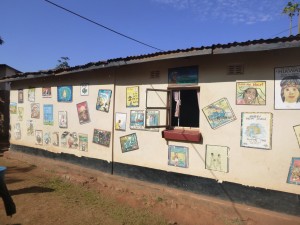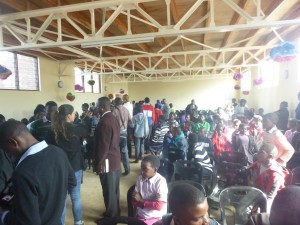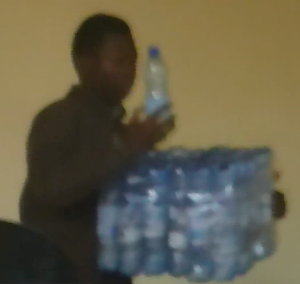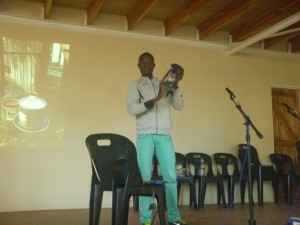Last Thursday I had the great honor to visit Jacaranda School for Orphans . The other interns and I were invited to come and speak to the students about the various BTB technologies we had brought/made and what we are doing in Blantyre this summer. When the visit was first pitched to us, I’ll be honest and admit I wasn’t too fond of the idea. It would require us taking a morning off of work to go talk to a bunch of rowdy kids who probably wouldn’t understand or care about what we had to say. I freely and happily admit my preconceptions couldn’t have been more wrong.
Almost immediately after disembarking the taxi, we were graciously greeted by the school director and two bubbly students – Alinafe and Jarrod – who would serve as our tour guides. The dynamic duo walked us all around the campus’s pristinely manicured gardens and brightly painted buildings. We walked into several classrooms, and without fail, were greeted with a standing ovation and a dozen or more smiling faces.


After our tour of the facilities – including classrooms, a library, a clinic, a computer lab, a small barn, and an arts and crafts garage – we were taken to a large room where all of the students had been assembled. There was a buzz of excitement in the air.

We were treated to two performances from the school’s student a cappella groups. The boys gave a spirited rendition of “The Lion Sleeps Tonight,” and the girls a beautiful song called “Malaika.” Then the director of the school called up two students to talk about projects the students had been working on. The first boy proudly presented cubes of tightly packed used water bottles that were lashed together with recycled plastic. He demonstrated using them as chairs, tables, foot rests, and when he lined them up, a bed. The next student showed off one of the solar lights he had made using old tin cans and plastic peanut butter jars. The beauty of this project is that the students made enough solar lamps so that every child who attends Jacaranda can take one home with them to study at night. (Considering it gets dark here around 5:30 p.m. and electricity is not always reliable or available, the solar lamps are a real game-changer for these students.)


After all the Jacaranda student presentations, the 9 of us went up on stage. Just introducing ourselves with what we studied and where we were from garnered applause. (We later found out from the school director that the students’ understanding of engineers was limited to people who work on cars, so it must have been really exciting for them to meet students studying biomedical, electrical and industrial engineering.) Christina took the lead and talked about the work we’d been doing with the phototherapy dosing meter, but ended her speech with a few words of personal advice for the girls in the crowd who are decidedly underrepresented in Malawian higher education. (Christina is one of 3 female electrical engineers in her class year at the Poly. There are no female mechanical engineers her year.)
Then we collectively gave overviews of the other devices we brought: the bCPAP and respiratory rate timer. When we finished, the school director opened the floor to questions, and dozens of students’ arms shot up. Because of the large age rage of the students, the questions varied quite a bit in complexity, (including, “Does the breath machine use electricity?” in reference to the bCPAP to, “Describe the calibration methods you used to increase the robustness of your phototherapy dosing meter,”) but all were equally brazen and hungry for understanding.
Francis closed out our presentation with some apt advice: “If you want to go fast,” he said, “go alone. But if you want to go far, go together.”
One of my favorite moments from the visit was an insightful parallel that Marie – the founder of Jacaranda – drew. She had just returned from a few week visit to Texas, and had witnessed the aftermath of all the recent flooding there. Certainly, Malawi experiences much more extensive and devastating flooding than Texas, but Marie noted that despite so many obvious differences between the two places, Texans and Malawians still experience some of the same problems, and in that way we are united. “In Texas, it flooded, homes were lost, people died. In Malawi, it flooded, homes were lost, people died,” she remarked, “We are the same.”She used this comparison to encourage and inspire her students that they could do anything they set their minds to.
The joy, hope and excitement at Jacaranda was contagious. At several points during the visit I found myself working very hard to hold back tears because of how inspiring it was. As we were leaving, we talked with the director to see if we could come back and chat some more with the students because we were all equally moved by the experience. Next Friday we’ll be going back to give a mini engineering design workshop for any student that wants to attend. (And after last week’s receptions, I get the feeling there will be quite a few very eager students in attendance.) I can’t wait to go back. In a way, it is unrelated to our internship in Malawi this summer, but at the same time, I think it couldn’t be more relevant. The spirit and mission of Jacaranda are beacons of hope, and I believe it is equipping its students to be the future leaders of a better and brighter Malawi.